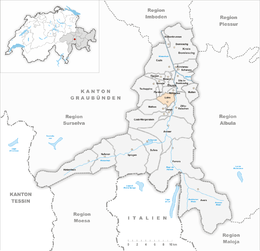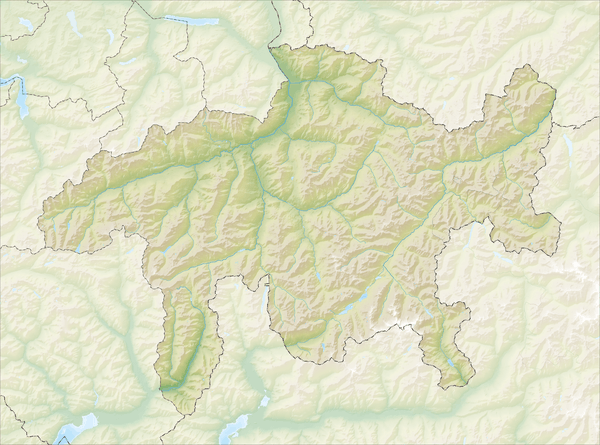Lohn, Graubünden
| Lohn | ||
|---|---|---|
 | ||
| ||
 Lohn | ||
|
Location of Lohn   Lohn Lohn (Canton of Graubünden) | ||
| Coordinates: 46°39′N 9°25′E / 46.650°N 9.417°ECoordinates: 46°39′N 9°25′E / 46.650°N 9.417°E | ||
| Country | Switzerland | |
| Canton | Graubünden | |
| District | Viamala | |
| Government | ||
| • Mayor | Fritz Bräsecke | |
| Area[1] | ||
| • Total | 8.17 km2 (3.15 sq mi) | |
| Elevation | 1,585 m (5,200 ft) | |
| Population (Dec 2016[2]) | ||
| • Total | 44 | |
| • Density | 5.4/km2 (14/sq mi) | |
| Postal code | 7433 | |
| SFOS number | 3707 | |
| Surrounded by | Donat, Mathon, Rongellen, Thusis, Tschappina, Urmein, Zillis-Reischen | |
| Website |
www SFSO statistics | |
Lohn (Romansh: Lon) is a municipality in the Viamala Region in the Swiss canton of Graubünden.
History
Lohn is first mentioned in mid-12th Century as Laune and Lune. In 1219 it was mentioned as de Laone.[3]
Geography
Lohn has an area, as of 2006, of 8.1 km2 (3.1 sq mi). Of this area, 56.5% is used for agricultural purposes, while 35% is forested. Of the rest of the land, 1.5% is settled (buildings or roads) and the remainder (7%) is non-productive (rivers, glaciers or mountains).[4]
Before 2017, the municipality was located in the Schams sub-district, of the Hinterrhein district, after 2017 it was part of the Viamala Region.[5] It is a haufendorf (an irregular, unplanned and quite closely packed village, built around a central square) located at an elevation of 1,582 m (5,190 ft) on the upper Schamserberg.
Demographics
Lohn has a population (as of 31 December 2016) of 44.[2] Over the last 10 years the population has decreased at a rate of -10.7%.[4]
As of 2000, the gender distribution of the population was 44.0% male and 56.0% female.[6] The age distribution, as of 2000, in Lohn is; 5 people or 10.0% of the population are between 0 and 9 years old. 9 people or 18.0% are 10 to 14, and people or 0.0% are 15 to 19. Of the adult population, 1 person or 2.0% of the population is between 20 and 29 years old. 5 people or 10.0% are 30 to 39, 9 people or 18.0% are 40 to 49, and 1 person or 2.0% is 50 to 59. The senior population distribution is 10 people or 20.0% of the population are between 60 and 69 years old, 10 people or 20.0% are 70 to 79.[7]
In the 2007 federal election the most popular party was the SVP which received 45.1% of the vote. The next three most popular parties were the FDP (28.9%), the SPS (21.8%) and the CVP (4.2%).[4]
The entire Swiss population is generally well educated. In Lohn about 82.4% of the population (between age 25-64) have completed either non-mandatory upper secondary education or additional higher education (either university or a Fachhochschule).[4]
Lohn has an unemployment rate of 0%. As of 2005, there were 23 people employed in the primary economic sector and about 7 businesses involved in this sector. people are employed in the secondary sector and there are businesses in this sector. people are employed in the tertiary sector, with businesses in this sector.[4]
The historical population is given in the following table:[3]
| year | population |
|---|---|
| 1780 | 126 |
| 1850 | 97 |
| 1900 | 75 |
| 1950 | 62 |
| 2000 | 50 |
Languages
Most of the population (as of 2000) speaks Rhaeto-Romance (52.0%) and the rest speak German (48.0%).[4]
| Languages in Lohn | ||||||
| Languages | Census 1980 | Census 1990 | Census 2000 | |||
| Number | Percent | Number | Percent | Number | Percent | |
| German | 0 | 0.00% | 18 | 37.50% | 24 | 48.00% |
| Romanish | 36 | 100% | 30 | 62.50% | 26 | 52.00% |
| Population | 36 | 100% | 48 | 100% | 50 | 100% |
References
- ↑ Arealstatistik Standard - Gemeindedaten nach 4 Hauptbereichen
- 1 2 Swiss Federal Statistical Office - STAT-TAB, online database – Ständige und nichtständige Wohnbevölkerung nach institutionellen Gliederungen, Geburtsort und Staatsangehörigkeit (in German) accessed 30 August 2017
- 1 2 Lohn in German, French and Italian in the online Historical Dictionary of Switzerland.
- 1 2 3 4 5 6 Swiss Federal Statistical Office Archived 2016-01-05 at the Wayback Machine. accessed 7 October 2009
- ↑ Swiss Federal Statistical Office - Amtliches Gemeindeverzeichnis der Schweiz - Mutationsmeldungen 2016 accessed 16 February 2017
- ↑ Graubunden in Numbers Archived 2009-09-24 at the Wayback Machine. (in German) accessed 21 September 2009
- ↑ Graubunden Population Statistics Archived 2009-08-27 at the Wayback Machine. (in German) accessed 21 September 2009
| Wikimedia Commons has media related to Lohn GR. |
